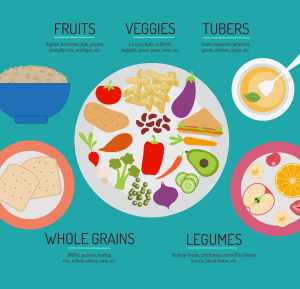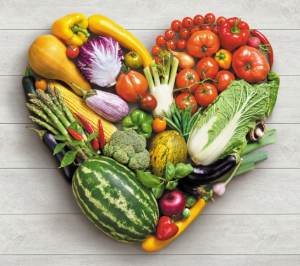In case you have stumbled upon this newsletter or are even curious about making the switch to a plant-based diet, congratulations on your first step. Nowadays, “plant-based” is a buzzword surrounding us in our everyday life, sounding clean and healthy. But how exactly does one get started?
What does this healthy diet include?
Despite being free from animal products, a plant-based diet can be truly versatile! The healthy and varied diet constitutes of vegetables and fruits, legume, whole grain and cereals, nuts and seeds (Figure 1) (Imatome-Yun 2019).
The transition towards plant-based eating can be deemed to open a range of culinary possibilities. One of the ways to embrace this diet is to think of the foods and ingredients one can add as options to the overall intake rather than focusing on what one is decreasing or eliminating from the diet. Having pointed it out, the key to a nutritionally sound diet is the variety. A gradual way to jumpstart is to introduce more protein-rich meat alternatives like beans, lentils, tofu etc. and dairy alternatives. However, just reducing or eliminating animal products does not automatically mean a plant-based diet is healthy. It is also vital to reduce or avoid unhealthful foods, such as: sugary foods, refined white carbohydrates, deep fried and greasy foods. Moreover there are a couple of nutrients which deserve extra attention when embarking on a plant-based diet, namely iron, calcium and vitamin B12. Iron is found in leafy green vegetables, whole grains, lentils, peas, and dried fruits! Adding foods rich in vitamin C will also help iron absorption. Calcium sources include leafy green vegetables, broccoli, tofu, tempeh, tahini, almonds, and black beans. In case of B12, many plant foods, like plant-based yogurt and milk are fortified with it (Arnarson 2019). Good understanding and planning can help one in getting enough of them in a plant-based diet.

Figure 1. Components of a plant-based diet (Imatome-Yun 2019)
blank
Tips to help you get started
Over time, eating a plant based diet will become a second nature. Here are some ideas to get started:
- Swap: Swap your regular dairy or meat products to plant-based alternatives, such as oat-based yoghurt or soya-based burgers
- Meatless Monday: Start with one day a week and gradually increase your plant-based behaviours
- Two meals a day: Alternatively, start with two plant-based meals a day
- Experiment: Look up tasty plant-based recipes and try out new foods
- Share: A plant-based meal tastes best when you share it with your friends or family
- Research: Try to do some research to be sure from which sources you can get your calcium, iron and protein
- Be rich: Swap meat for legumes and you will save a lot of money
- Treat yourself: Go to vegetarian restaurants to enjoy a good meal
- Main meal: Instead of vegetables and legumes as a side, consider them as the main component of you meal
- Stay positive: Be proud of all days you have been eaten plant-based, do not worry if you have cheated once in a while
Blank
Blank
Blank

Figure 2. (Source: Harvard Health Publishing 2019)
Watch out for these trends…..
Because who said transitioning to a plant-based diet has to be boring
- Unconventionally “healthy” desserts – like new ice cream innovations, bean-based brownies and blondies, dessert hummus and hummus milkshakes.
- Jump on the vegan fast food wave – no one said it needs to healthy!
- Unusual seed and nut butters – almond and peanut butter are staple foods in plant-based diets, but hemp, watermelon and pumpkin seed butters are shaking up the market.
- Fungi – the high variety and versatility of the kingdom made them the “it” food to turn the fungi into everything from burger substitutes to highly addictive shiitake bacon.
- Swap 2.0 – While there is nothing wrong with your typical pasta, to increase your legume intake and to vary the taste, new traditional products made from legume are entering the market. Whether as pasta, rice or plain flours – legumes are both, versatile and nutritionally dense, making them a great swap for yoghurts, eggs, cheeses or others.
- Vegan blogs or cookbooks – you might just be wondering how to cook vegetable-based meals that are nutritionally balanced. Get inspired by dedicated chefs who share their most mouthwatering recipes.
Still stuck with us, here are two easy-everyday recipes as a bonus:
RECIPE 1: 2-minutes plant-based milk
How to make a non-dairy milk fast: you’ll just need two ingredients: a plant-based ingredient of your choice (i.e. any kind of nut or seed butter, coconut flakes, oats) and water; plus: a mixer.
Ingredients for 1 liter of milk:
- 4 tablespoons plant-based butter
- 1-liter water
- Optional: throw in a couple of dates or raisins for a natural sweetness
How to make it?
- Pour the water into the blender and add the almond butter and dates, if using. Blend them, until creamy and make sure the dates are broken down.
- Optional: Filter the milk through a cloth.
- Pour the milk into an airtight storage container and keep it in the fridge for up to 4 days. Use it in your coffee, over cereal, granola, chia pudding, or in smoothies.
Blank
RECIPE 2: 2-minutes plant-based nut butter
Ingredients for one jar of homemade nut butter:
- 250 g of roasted nuts, seeds of your fantasy
- Up to 1/2 teaspoon of fine salt
- Optional: mild oil (i.e. vegetable or nut), cinnamon, vanilla
How to make the nut-butter?
- Preheat your oven to 200 °C and spread 250 g of nuts or seeds of your choice (i.e. peanuts, almonds, cashews, sunflower seeds, hazelnuts) in a single layer on a baking sheet. Toast them for 5 – 10 minute, until you smell a delicious nutty flavor.
- Remove the nuts and immediately dump them in your food processor along with the salt. Process the nuts for 5 – 20 minutes, scratch down the sides of the food processors frequently.
- Taste your nut butter and add salt or other flavors as desired.
- Transfer the butter in a sealable and sterilized container and store it in the refrigerator.
Last but not the least, don’t be too hard on yourself!
It is quite obvious, that it is a lot at once and at the same time, a shift of the diet isn’t for everyone. Shift the focus to the food and ingredients that you are adding to the diet rather than what you are taking away. Just focus on the big changes – such as switching from animal-based products to legumes, use of whole grains and starchy veggies (like potatoes). Keep in mind that it is about finding out what works for you, so be gentle in finding your pace in incorporating plant-based foods.
References
- Arnarson, Alti. 2019. Healthline. October 31. Accessed January 07, 2020. https://www.healthline.com/nutrition/7-nutrients-you-cant-get-from-plants#1.
- Imatome-Yun, Naomi. 2019. Forks over Knifes. January 05. Accessed January 07, 2020. https://www.forksoverknives.com/plant-based-primer-beginners-guide-starting-plant-based-diet/#gs.ug6ajf.
- Harvard Men’s Health. 2018. Harvard Health Publishing. January. Accessed January 07, 2020. https://www.health.harvard.edu/staying-healthy/the-right-plant-based-diet-for-you.

 An integrated food quality research and training programme
An integrated food quality research and training programme